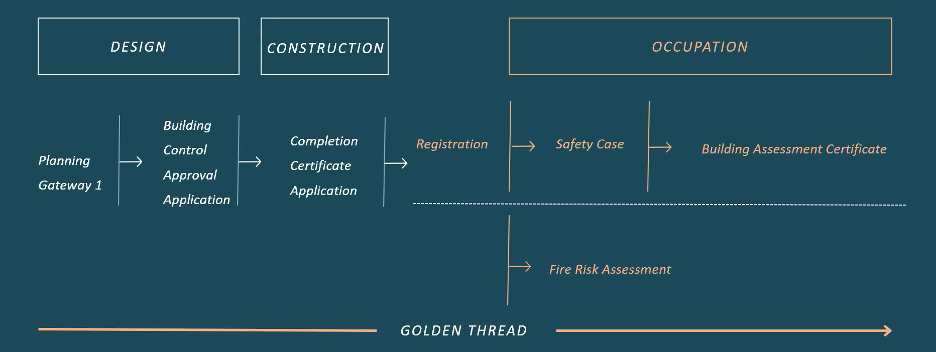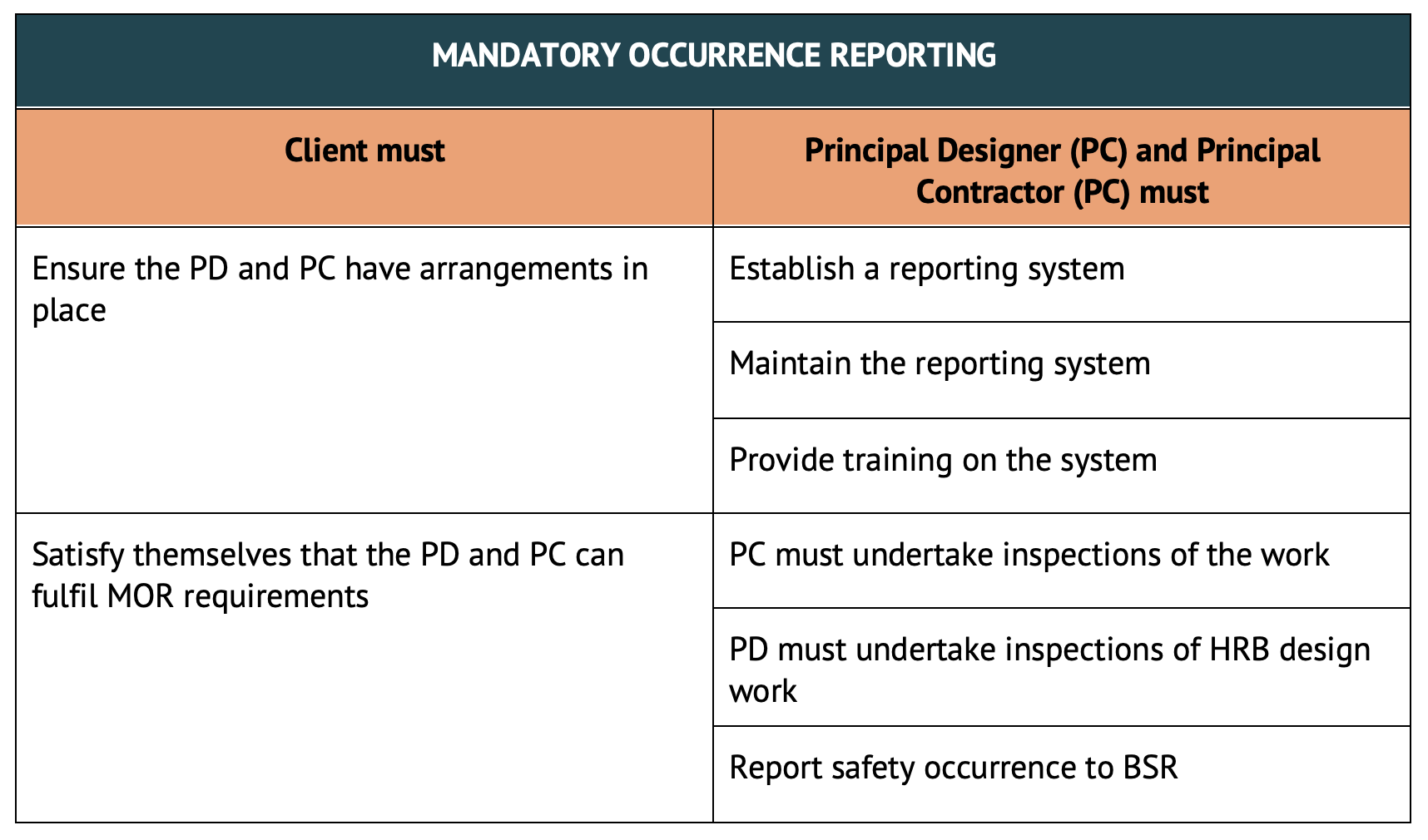Complying with the Building Safety Act – the role of the Golden Thread
The Building Safety Act and related regulations have had a massive impact on the property and construction sector in England. These changes place increased responsibility and accountability on clients as dutyholders under the Act, and demand that they meet stringent requirements both during the design and construction and in occupied buildings, to ensure that buildings are safe for those who use them.
To comply with the legislation, clients must create, hold and maintain a ‘golden thread’ of information throughout the lifecycle of a building. By providing accurate, comprehensive, and up-to-date information in an easily accessible digital platform, clients can ensure that they comply with the relevant regulations and operate in a safe, transparent, and compliant way.
If you are a client, read on to learn more about the golden thread and what your responsibilities are under the legislation.
In this article, we cover:
- What the golden thread is, and how recent changes to the Building Safety Act have impacted it
- An overview of some of the new documentation you now need for your golden thread at Gateway 2 and Gateway 3
- Best practices for creating and maintaining your golden thread digitally
- The benefits of a well-maintained golden thread
What is the ‘golden thread’ and how does it relate to the Building Safety Act?
The Building Safety Act places a duty on the client to obtain, create, keep, give and keep up to date information or documents in accordance with prescribed standards. This is the golden thread of information.
The concept of the ‘golden thread’ refers to a complete electronic record of key information about your building that is accessible to stakeholders. It goes from inception (when you start your design) right through to handover and occupation—so it needs to be created before building work starts.
Throughout design and construction, the golden thread must be updated and maintained by the client and the principal dutyholders who are the principal designer and principal contractor. Once the building is completed, this information is handed over to the person who is responsible for the building in occupation, known as Accountable Person, who must ensure that it is kept up to date.
Overall, the golden thread creates a single source of truth for all information about your building, encompassing all the documentation and evidence you need to demonstrate that you have complied with your duties under the Act.
Clients can no longer outsource this work, they must actively engage in the process:
- They (or a representative) must submit the gateway applications
- They must provide an electronic facility to digitally store and access the golden thread of information
- They must maintain this electronic facility, ensure information is updated within it, and hand over information within the facility.
Moreover, clients need to take a robust approach to record-keeping to ensure they not only meet but can evidence compliance.
What types of information are needed in the golden thread?
Your golden thread should include the following types of information:

In light of the amendments, let’s focus on some of the biggest changes impacting the golden thread at Gateway 2 and Gateway 3.
Gateway 2: Building Control Approval Application
As part of your Building Control Approval Application, you need the following documents:
- Building Control Approval Application
- Boundary site plan 1:1250
- Plans to show HRB work complies with Building Regulations (doesn’t specify which plans to provide, it’s up to your team to work out what you need to provide to demonstrate your compliance
- Competence declaration
- Building Regulations compliance statement
- Fire and Emergency File
- Construction Control Plan
- Change Control Plan
- Mandatory Occurrence Reporting Plan
- Partial Completion Strategy (if applicable).
The biggest changes are in the Competence declaration, Construction Control Plan, Change Control Plan, and Mandatory Occurrence Reporting Plan. These are new systems developed under this regime, so let’s take a look at these documents in a little more detail and outline how they impact the golden thread.
Competence declaration
This is a declaration by the client (or their authorised representative) that shows they have satisfied themselves that the principal designer and principal contractor are suitable for the roles they’re going to undertake.
It needs to not only prove that the client has assessed their competence, but also demonstrate how they have determined this competence.
How can you assess competence? Follow these helpful frameworks:
- PAS 8671:2022 Framework for Competence of Individual Principal Designers
- PAS 8672:2022 Framework for Competence of Individual Principal Contractors
Construction Control Plan
In the Construction Control Plan, the client sets out the strategies, policies, plans, and procedures for various elements such as:
- Planning, managing, and monitoring of the HRB work
- Identifying, assessing, and reviewing the competence of people carrying out the HRB work
- Supporting cooperation between designers, contractors, and others
- How and when the Construction Control Plan will be reviewed, and how you’ll enact any lessons learned.
Change Control Plan
This is where the client sets out the strategies and plans for how they’re going to control change on the project. This includes:
- How to identify change
- Who to report change to
- Who reviews and agrees to change
- How you determine the category of change
- Where you will record change and when does it need to be recorded by
- How you will review the Change Control Plan once it’s in place.
Mandatory occurrence reporting
For the mandatory occurrence reporting, the onus is primarily on the principal dutyholders rather than the client. However, the client is still responsible for ensuring that the Principal Designer and Principal Contractor have put these arrangements in place and can fulfil these requirements.
Here’s a breakdown of the responsibilities for mandatory occurrence reporting:

Gateway 3
Once your application has been approved and you move into the construction stage, you need to ensure you follow the processes you outlined above.
In particular, it’s crucial that your Change Control Plan is kept up to date. Although the principal contractor creates and maintains the change control log, it’s the client’s responsibility to ensure records are being made. The client also needs to ensure that any information that has been revised because of these changes gets saved in the electronic facility.
To apply for your Completion Certificate Application, the documents you need for your golden thread include:
- Signed Building Completion Certificate Application
- As built plans and information
- Final versions of key documents provided at Gateway 2: Building Regulations Compliance statement, Fire and Emergency File, Mandatory Occurrence Reporting Plan, Change Control Plan, Construction Control Plan
- Change Control log
- Information captured to demonstrate compliance with Building Regulations
- Signed compliance declaration
- Signed handover declaration.
The signed handover declaration is the biggest change as a result of amendments to the Building Safety Act. Now, the handover declaration must be signed not only by the client but by the relevant person to confirm that they’ve received and understood the information provided.
Note: Depending on the building, the relevant person is either the accountable person (for a residential HRB) or the responsible person (for a hospital or a care home).
As part of this new regime, the client has to transfer the golden thread of information electronically, and there can’t be a risk of files being lost or corrupted. This means that old ways of working like USBs won’t suffice as your electronic facility.
Best practices and strategies for storing and managing building information digitally
So, what do all these changes and new requirements mean for how you create, manage, and maintain your golden thread? Here are some best practices you need to take on board.
Use a built-for-purpose electronic facility
With so many moving parts, as well as the increased responsibility placed on the client, you need to implement an electronic facility that was created with these complex requirements in mind. As we’ve already seen, using USBs won’t cut it: you need a secure cloud-based, collaborative system that accurately tracks all information in real time. With the right electronic facility, you create a single source of truth in one central repository, maintaining a reliable and accessible golden thread.
Choose a tool that enables collaboration
Throughout the project, you’ll need multiple stakeholders to feed into your golden thread. Look for an electronic facility that makes it easy for people to collaborate effectively so you can maintain compliance and ensure all records stay up to date. Maintain a clear audit trail to record how specific documents achieve the relevant status, so you alway know who did what, when, increasing accountability and visibility.
Implement a competency review process
Create a repository of supporting evidence to prove competency, and provide evidence that it’s been reviewed by the appropriate people. For example, in request key documentation around competencies—such as previous experience, qualifications, and membership status with industry organisations—and assign reviewers to approve and sign off on them.
Monitor KPIs
As your project progresses, you need to demonstrate that you’re following the processes and procedures you’ve outlined. Using a built-for-purpose tool, you can monitor your performance with visual dashboards to get at-a-glance insights. For example, schedule all inspections that need to be carried out, and measure planned vs. actual to ensure everyone is actively performing their duties. Use these dashboards and KPIs to track individual performance, identify issues, and keep your project on track.
The benefits of a well-maintained golden thread
Maintaining the golden thread isn’t just a matter of compliance: it also provides a range of benefits, such as improved safety, increased transparency, and enhanced efficiency.
Improved safety
The ultimate goal of these amendments is to ensure that buildings are safe for the people who occupy them. Your golden thread lets you operate with confidence that all safety requirements have been met, so you can be sure you’re contributing to a safer, better built environment.
Increased transparency
The golden thread provides increased clarity and visibility at every stage of your project, letting you see exactly what happened, when, and by whom. This transparency reduces risk and increases accountability, enabling all stakeholders to work with context.
Enhanced operational efficiency
Using the right electronic facility to maintain your golden thread streamlines the management of multiple documents and review processes, ensuring nothing gets overlooked. Creating a single source of truth for all information about your building helps you work more efficiently by reducing operational delays due to missing documentation; ensures all stakeholders have access to the information they need to perform work and make data-driven decisions; and helps you identify problem areas or blockers that you may need to investigate further—before they become issues.
Build safer buildings with a reliable, secure golden thread
Your building’s golden thread ensures it meets rigorous safety standards, improving the built environment and protecting you from financial and reputational risk. Using a powerful system to manage, monitor, and maintain your golden thread puts you in control, ensuring nothing falls through the cracks.
Catalyst’s purpose-built system Obi was made with the golden thread’s complex needs in mind. Originally designed to certify buildings under the Irish BCAR legislation, Obi has been used to deliver billions worth of construction assets. Its built-in approval and review processes, secure and easy-to-use platform, and robust document management empower you and your team to work safely, efficiently, and compliantly, creating a comprehensive golden thread for your asset.
Want to see Obi in action? Request a demo.